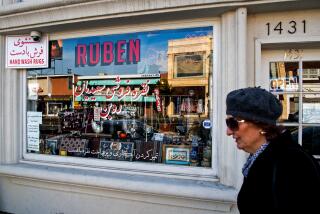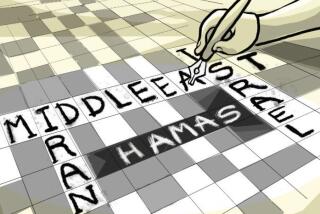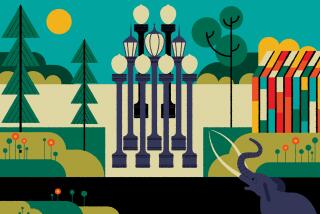Emerging From Shadows in Iran
Even as contemporary art extends its global reach amid a proliferation of international biennial exhibitions and art fairs, artists who labor under repressive governments have a tough time finding an audience away from home.
In the case of Iran, the artists who have risen to the international forefront--such as New York-based Shirin Neshat and Minneapolis-based Siah Armajani--have long since emigrated from their native land.
In light of this situation, two exhibitions in Los Angeles offer an unusual opportunity to see a slice of the contemporary art scene in Iran and, more fundamentally, to discover that there is one.
âOut of the Mist: A Panorama of Contemporary Iranian Art,â at the Don OâMelveny Gallery in West Hollywood, presents about 70 paintings by 20 artists. âA Breeze From the Gardens of Persia: New Art From Iran,â at the Los Angeles Public Libraryâs Getty Gallery, in downtown L.A., comprises 81 paintings, collages, prints and calligraphic works by 49 artists.
Independently organized and coincidentally scheduled to appear at the same time in Los Angeles, the shows make the point that Iran is not quite the cultural desert or prison that some Americans might envision. The works on view are far from the leading edge of the international scene. Still, they come from a country where a growing number of private galleries and a government-funded institution, the Museum of Contemporary Art in Tehran, actively promote artistsâ careers and encourage them to express themselves--provided they donât criticize the current regime or venture into forbidden territories of politics, religion and nudity.
âIran is ruled by an Islamic fundamentalist government,â says Homa Taraji, who organized âOut of the Mist,â at the OâMelveny Gallery. âWhoever lives there has to abide by that. But as long as the artists donât deal with objectionable topics, there is no problem.â
That isnât exactly an ideal climate to nurture art that accurately reflects its social and political milieu, but artists find subtle ways of getting around taboos, Taraji says. Whatâs more, she adds, government officials rarely look below the surface of the art.
Paintings by Hossein Khosrojerdi, for example, portray figures who are wrapped in bandages and soaked in mud, amid a dark sea of debris. The scenes are shrouded in mystery, but they portray Iranians who have had âan Islamic identity imposed on themâ and are searching for their Persian roots, Taraji says.
Two works by Shahla Etemadi appear to be contemplative views of the patterns and shapes made by light on water. They actually reflect the artistâs thoughts about a society that forbids men and women to mingle in public places, Taraji says. Images in the paintings are based on a curtain installed in the Caspian Sea to provide separate swimming areas for men and women.
An Art Scene Rises in Iran
Working with Iranian contemporary art is a relatively new experience for Taraji, an Iranian who came to Los Angeles in 1975 as a graduate student at USC. Having earned a masterâs degree in physics and electronics from Tehran University, she wanted to further her education with a masterâs degree in computer science. She got a summer job at Jet Propulsion Laboratory while studying at USC and continued working there for a couple of years after finishing her degree.
Taraji had an airline ticket to return home on Nov. 6, 1979--two days after Americans were taken hostage in Tehran. âMy father called and said, âJust stay a few weeks until things settle down.â The rest is history,â she says.
Instead of going home as planned, Taraji worked in the fields of aerospace and information technology in Los Angeles. But last year she decided it was time for a change and began thinking about becoming involved in art, a lifelong interest she had not pursued professionally.
âSomething called me back to Iran,â says Taraji, who hadnât been there for 15 years and who had vowed never to return. To her amazement, she discovered a flourishing art scene. âTen years ago, there were only three contemporary art galleries in Tehran; now there are 40-plus,â she says. âThere are so many artists, the galleries change their exhibitions weekly.â
She also discovered that the Museum of Contemporary Art in Tehran, which maintains a major international collection of modern and contemporary art built by Shah Mohammed Reza Pahlavi during the 1960s and â70s, had become an active advocate of Iranâs contemporary art. Moribund for a long time after the revolution, the museum has been energized during the last few years by director Ali Reza Sami-Azar, Taraji says.
âThey have a permanent collection that is on display and on loan to other museums, though not to the United States because of fear that it wonât be returned. They also support the participation of Iranian artists in international exhibitions,â she says. The museumâs staff does not exercise curatorial control over these exhibitions, but âthey are willing to pick up the tab for travel, shipping, insurance and related costs,â she says.
The goal is to âopen doors for Iranian artists and help them get the international recognition they deserve,â she says. And thatâs her new mission as well. She became the U.S. liaison to the museum and is setting up a nonprofit foundation that will organize touring exhibitions of Iranian contemporary art. âOut of the Mist,â which was underwritten by the museum, is the first public step of her long-range plan.
The museum also played a major role in âA Breeze From the Gardens of Persia,â at the library. Spearheaded by the Meridian International Center--a nonprofit institution in Washington, D.C., that promotes understanding through cultural exchanges--and underwritten by corporate sponsors, the exhibition is a collaborative venture with the museum and Tehran Arts University.
To organize the show, Nancy Matthews, vice president for Meridianâs arts initiative, made five trips to Iran and visited hundreds of artists. âWe wanted to illustrate the theme that contemporary art reflects Persian culture and to present a cross-section of whatâs going on in the contemporary art scene,â she says.
Art Expression Blossoms Forth
As word of her project got out, she was overwhelmed with possibilities. âEveryone wanted to be in it,â she says. The show she selected features a diverse group of works that range from traditional calligraphic and miniature paintings to Western-influenced landscapes, portraits and abstractions.
Taraji offers two reasons for Iranâs contemporary art boom. âAfter the revolution, the cut-off of Western-style entertainment made young people pick up art as a pastime. There was a demand for more art schools, and more schools opened. That helped. Also, after the revolutionary spirit subsided, people began demanding a better economy and social life and less restrictive Islamic rules. They picked up art as a means of expression. In any country where there are restrictions of freedom of speech, people find a way of expressing themselves.â
*
âOut of the Mist: A Panorama of Contemporary Iranian Art,â Don OâMelveny Gallery, 9009 Melrose Ave., (310) 273-7868. Tuesdays-Saturdays, 11 a.m.-6 p.m. Ends June 30.
âA Breeze From the Gardens of Persia: New Art From Iran,â Los Angeles Public Library, Getty Gallery, 630 W. 5th St., (213) 228-7000. Mondays-Thursdays, 10 a.m.-8 p.m.; Saturdays, 10 a.m.-6 p.m.; Sundays, 1-5 p.m. Ends Aug. 4.
More to Read
The biggest entertainment stories
Get our big stories about Hollywood, film, television, music, arts, culture and more right in your inbox as soon as they publish.
You may occasionally receive promotional content from the Los Angeles Times.










